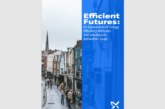
PBM Editor Paul Davies used his Viewpoint column in the magazine’s November edition to discuss the Green Homes Grant scheme.
Speaking at the Conservative Party’s ‘virtual’ conference in early October, the Prime Minister delivered a resolutely upbeat speech that, whilst perhaps lacking in detail and paying only lip service to addressing the ongoing Covid challenge of today, offered a longer term vision of a greener, greater Britain.
Continuing with the Government’s ongoing theme to (literally) ‘Build Back Better’ in the aftermath of the coronavirus crisis, the PM reiterated the pledge to “fix our broken housing market” and to “transform the sclerotic planning system” whilst reasserting plans to “make it faster and easier to build beautiful new homes without destroying the green belt or desecrating the countryside.”
Coupled with the ‘Planning for the Future’ White Paper launched by Housing Secretary Robert Jenrick back in August, the Government messaging is certainly consistent on this issue, and should offer great encouragement for the building industry as it navigates its way through the day-to-day constraints of a nation still gripped by the pandemic with its rolling series of local lockdowns and prolonged economic uncertainty.
A commitment to driving up design standards for new homes, including an adherence to minimum space standards for residential conversions under Permitted Development Rights, can also be seen as a boost to the supply chain. For example, the Federation of Master Builders’ Chief Executive Brian Berry commented recently: “Everyone deserves the right to a decent home and I’m grateful that the Housing Secretary has listened to the calls from a range of organisations, including the FMB, and that a loophole for unscrupulous builders has now been closed.
“Permitted Development Rights should offer local builders the opportunity to help homeowners upgrade their homes and create more space, as well as to bring life back into our dying high streets. But quality must not be compromised. Ensuring that these opportunities are open to small, local builders will mean more jobs retained and created in our communities.”
Of course, new build is only one part of the sustainability equation and, in recent weeks, the Government has also launched the Green Homes Grant scheme to subsidise a raft of energy-efficient home improvement measures. We explore the scheme in greater depth elsewhere in the issue, but the key point for the sector is that it appears to work in harness with the existing supply chain, affording opportunities to merchants and their trade customers that were catastrophically ignored by previous, doomed initiatives such as the Green Deal.
Yet this time-limited scheme must be more than just another false start, with a comprehensive long-term strategy required to facilitate the successful retrofit of the nation’s 28 million homes, especially when considering the Government’s 2050 zero carbon target and the projection that 85% of our existing homes will still be standing in thirty years.
Returning to the Prime Minister’s speech, the rhetoric is certainly uplifting and measures such as the Green Homes Grant are indeed beginning to be rolled out. Yet whilst a conference speech is intended to serve as an upbeat rallying cry rather than a deep dive into policy detail, it has to be set against the fact that we have a long winter ahead with the shadow of Covid still looming over us.
For the country to truly ‘Build Back Better’, the immediate problems still have to be addressed.
“The time-limited Green Homes Grant scheme must be more than just another false start.”



